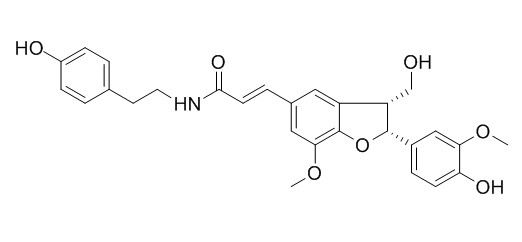Grossamide K
Grossamide K exerts a particularly strong anti-melanogenic activity on the cells without high cell toxicity.
Inquire / Order:
manager@chemfaces.com
Technical Inquiries:
service@chemfaces.com
Tel:
+86-27-84237783
Fax:
+86-27-84254680
Address:
1 Building, No. 83, CheCheng Rd., Wuhan Economic and Technological Development Zone, Wuhan, Hubei 430056, PRC
Providing storage is as stated on the product vial and the vial is kept tightly sealed, the product can be stored for up to
24 months(2-8C).
Wherever possible, you should prepare and use solutions on the same day. However, if you need to make up stock solutions in advance, we recommend that you store the solution as aliquots in tightly sealed vials at -20C. Generally, these will be useable for up to two weeks. Before use, and prior to opening the vial we recommend that you allow your product to equilibrate to room temperature for at least 1 hour.
Need more advice on solubility, usage and handling? Please email to: service@chemfaces.com
The packaging of the product may have turned upside down during transportation, resulting in the natural compounds adhering to the neck or cap of the vial. take the vial out of its packaging and gently shake to let the compounds fall to the bottom of the vial. for liquid products, centrifuge at 200-500 RPM to gather the liquid at the bottom of the vial. try to avoid loss or contamination during handling.
Phytomedicine.2019, 55:229-237
bioRxiv - Biochemistry2023, 548213.
Nutrients.2023, 15(24):5020.
Life (Basel).2022, 12(10):1630.
Life (Basel).2022, 12(12):2107.
The Journal of Agromedicine and Medical Sciences2018, 4(1)
Am J Chin Med.2015, 30:1-22
Psychopharmacology (Berl).2020, 10.1007
BMC Complement Altern Med.2014, 14:352
Int J Mol Sci.2022, 23(24):16000.
Related and Featured Products
J Agric Food Chem. 2010 Apr 28;58(8):4779-85.
Lignans from the tuber-barks of Colocasia antiquorum var. esculenta and their antimelanogenic Activity.[Pubmed:
20359228]
Colocasia antiquorum var. esculenta , a variant of C. antiquorum , commonly known as "Imperial Taro", is an edible vegetable in many tropical and subtropical regions of the world.
METHODS AND RESULTS:
This study with the aim of evaluating the potential of C. antiquorum var. esculenta as a functional food with a depigmenting effect resulted in the identification of a new sesquilignan, named colocasinol A (1), and a new acyclic phenylpropane lignanamide, named cis-Grossamide K (2), together with 10 known compounds (3-12). The identification and structural elucidation of these compounds were based on 1D and 2D nuclear magnetic resonance (NMR) spectroscopic data analysis as well as high-resolution fast atom bombardment mass spectrometry (FABMS) and electron impact mass spectrometry (EIMS). Quantitation of the melanin contents and cell viability in murine melanocyte melan-a cells was used to assess the antimelanogenic activities of the isolated compounds.
CONCLUSIONS:
Among them, cis-Grossamide K (2), isoamericanol A (3), americanol A (4), 2-hydroxy-3,2'-dimethoxy-4'-(2,3-epoxy-1-hydroxypropyl)-5-(3-hydroxy-1-propenyl)biphenyl (5), and (-)-pinoresinol (6) showed inhibitory effects on melanin production. Compounds 2, 5, and 6 exerted a particularly strong antimelanogenic activity on the cells without high cell toxicity (IC(50) = 54.24, 53.49, and 56.26 microM, and LD(50) = 163.60, 110.23, and >500 microM, respectively).
Phytochemistry. 2001 Dec;58(8):1219-23.
Lignanamides and other phenolic constituents from the bark of kenaf (Hibiscus cannabinus).[Pubmed:
11738411]
METHODS AND RESULTS:
Two new acyclic phenylpropane lignanamides, Grossamide K and erythro-canabisine H, and the naphthol glucoside 2,5-dimethyl-3-O-beta-D-glucopyranosylnaphthol, along with six known compounds were isolated from the acetone extract of bark of Hibiscus cannabinus.
CONCLUSIONS:
All structures were established by spectroscopic methods including 2D NMR techniques, which allowed the correction of certain previously reported 13C NMR assignments of grossamide.



